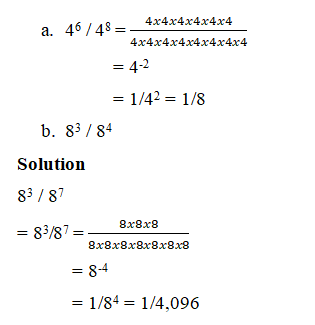Indices can be confusing if you do not really understand the meaning and various laws that govern them. In this lesson, I will give the definition of indices, breakdown various laws of Indices, and how to use the law of indices in calculations and simplification.
DEFINITION OF INDICES
Indices is the power of exponent which is raised to a number or variable.
Examples:
- The short form of writing m x m x m is m3. The letter “m” is called the base while the number 3 is the power, exponent or index.
- The short form of writing 8x8x8x8x8 is 85
Where the number 8 is the base and the number 5 is the power, exponent or index.
LAWS OF INDICES
- Multiplication Law
When numbers with equal bases are being multiplied, this powers (indices) are added.
Examples
- M2 X M3
Solution:
M2 X M3
Expand the powers of the base (M)
m2 = m3 (MxM)
M3 = (M x M x M)
Consider the relationship between the powers
Recall that you were told in this law that when Numbers with equal base are multiplied, their powers (Indices) should be added.
That means the relationship between the powers (2 and 3) is 5
So M2 X M3 = M2+3 = M5
- 93 x 94
Solution
93 x 94
Expand the powers of the bases (9)
93 = 9x9x9
94 = 9x9x9x9
Consider the relationship between the powers
The relationship between the powers (3 and 4) is 7
i.e 3 + 4 = 7
so, 93+4 = 97
In general,
am x an = am+n
Note
If two different numbers are multiplied, their powers or index are collected as one group to give the product
EXAMPLE
- 53 x 72 x 54 x 73
Solution
53 x 72 x 54 x 73
Collect like terms (Numbers or bases)
53 x 54 x 72 x 73
Consider their powers
53+4 x 72+3
Ans: 57 x 75
2. Division Law
When dividing numbers with the same base, the divisor is subtracted from the dividend.
EXAMPLE
87 / 85
Solution
87 / 85
87 is divided
85 is divisor

Consider the relationship between the powers.
Since you are solving with the division law, you are to subtract the powers that means, the relationship between the powers (7 and 5) is 2
7 – 5 = 2
So, 87 / 85 = 87-5 = 82
In general
ak / ay = ak-y
3. Power Law
When a number which is raised to a certain power is again raised to another power, it is said to be in powers; you have to multiply the two powers together for the final answer.
EXAMPLE

Expand the Numbers: 64 x 64 x 64
= (6x6x6x6) x (6x6x6x6) x (6x6x6x6)
= 6x6x6x6x6x6x6x6x6x6x6x6
= 612
Or

4. Zero Index
When any number is raised to power zero, the result will be 1
EXAMPLES
- am / am = am-m = a0 = 1
- 34 / 34
By using the division law
34 / 34 = 34-4 = 30 – 1
Or

5. NEGATIVE LAW
Any Number raised to a negative index or power equal the reciprocal raised to the positive index.
EXAMPLES

If you have any questions about the laws of indices, let us know in the comment section and if this article is helpful, do well to share it with others by clicking the social media share buttons.
